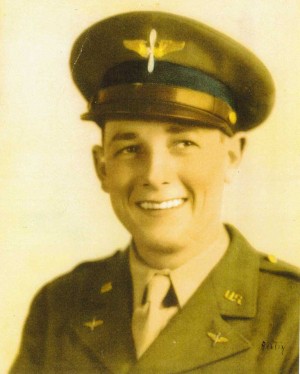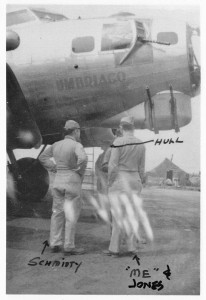08 Dec Umbriago
Last month at the 306th Bombardment Group reunion in Savannah two families of the crew of the B-17 “Umbriago” came together. The co-pilot William F. Griffin and his wife Charlotte reunited with the son and grandson of pilot Charles C. Wegener.
Not even two weeks after the reunion someone from Germany wrote a message (in German) on the armyairforces.com forum that “We have found wreckage of the B-17 “Umbriago” at Üdersee … the engine # SW-010 721.” He was looking for more information about the plane and crew for an exhibition at the Aviation Museum Finowfurt near Eberswalde, Germany.
This was a story right down my alley … the discovery of a B-17 from the 306th BG!
(12-8-2012: Update from the Discovery Crew. The wreckage was from the B-17 “American Eagle.” They do have an engine from the “Umbriago.”)
Here’s what I have put together so far. I will eagerly add and/or edit as I learn more.
In early 1944, back in the states the newly formed crew under pilot Charles C. Wegener decided that when they got to their base overseas they would name their B-17 “TASFUIA,” a military acronym for “Things are so fouled (or whatever) up it’s amusing.”
Once the airmen arrived at Thurleigh Airfield (306th BG, 367th BS) in June of ’44 they were assigned to a B-17G (serial # 42-97278) already named “Umbriago.” It’s bad luck to rename your ship, they were told. So “Umbriago” it was, a name familiar to every fan of Jimmy Durante who joked and sang about his mythical chum: “So when you feel low better send for my friend Umbriago.”
The Crew
- 1st Lt. Charles C. Wegener, pilot – POW
- 2nd Lt. William F. Griffin, co-pilot – POW Hospital
- 1st Lt. Donald C. Marsh, navigator – POW (died in 2004)
- Lt. William C. Stewart, Jr., bombardier – KIA (now at Zachary Taylor National Cemetery)
- T/Sgt. Joseph Stroyoff, engineer – POW
- T/Sgt. Jack P. Krahn, radio operator – KIA, conflicting reports
- Sgt. John V. Eden, ball turret gunner – KIA (now at Zachary Taylor)
- Sgt. William V. Gardiner, waist gunner – KIA (now at Zachary Taylor)
- S/Sgt. Henry H. Rodgers, tail gunner – KIA (now at Zachary Taylor)
On September 12, 1944, the 306th flew thirty-six aircraft to bomb oil refinery installations at Ruhland, Germany. Just north of Berlin the squadron encountered severe flak and lost two aircraft. Their formation broken, in six minutes six more aircraft were knocked down due to an attack by as many as twenty-five Focke-Wulf 190s.
2nd Lt. William F. Griffin, copilot, described the plane as “an instant wreck” after the fighter pass. All controls were shot out, the plane was completely sprayed with 20 mm cannon fire, and there was an oxygen fire. When the fighters hit the back of the plane two men were killed: Sgt. William V. Gardiner, waist gunner, and S/Sgt. Henry H. Rodgers, tail gunner.
“Umbriago” was seen to go down with its #3 engine on fire and the tail assembly shot away. According to the 367th BS Mission diary, four chutes were observed.
Crash at Üdersee
The plane crashed at Üdersee, a long narrow lake near Finowfurt, Germany, NE of Berlin.

2nd Lt. William F. Griffin
2nd Lt. William F. Griffin was the co-pilot, flying his 33rd mission. As he was falling slowly in his parachute one of the attacking FW 190 pilots came flying toward him, came in close, circled his parachute, then saluted and turned away.
Griffin crashed through the trees of pine forest. When he hit the ground his left ankle was fractured and his other ankle and both knees were injured. A branch from one of the trees above him cracked off, landed on him and broke his back. Somehow he was able to crawl under a bush to hide himself and his chute. Later in the afternoon he crawled closer to a dirt road and waved at a farmer. When the farmer asked Griffin if he were American, he nodded yes. The farmer called his wife to help carry the injured airman to their wagon. They carried him home, gave him bread and a beer and put him to sleep in their son’s bed, checking on him during the night. In the morning a policeman came to pick Lt. Griffin up. He was taken to a collection station where he was put in a bus with German soldiers.
William F. Griffin spent eight months in a POW Hospital in Meinnigen, Germany until the camp was liberated by General Patton’s 11th Armored Tank Division.
In 2002 Vance Stewart, the brother of bombardier Lt. William C. Stewart, Jr. wrote a book “Three Against One: Churchill, Roosevelt, Stalin vs. Adolph Hitler” in which he included a letter by navigator Lt. Marsh to the bombardier’s mother. The two airmen had flown together “in the nose” for three or four missions prior to the one on September 12th. Along with other members of the crew they were preparing to dive out when the plane started a spin. Lt. Stewart was thrown back up into the nose. The plane exploded before he was able to get out.
Marsh wrote that four of them were brought together as POW’s. My assumption is that three of the the POW’s were Pilot 1st Lt. Charles C. Wegener, navigator 1st Lt. Donald C. Marsh, and engineer T/Sgt. Joseph Stroyoff. Griffin was recovering in the German hospital.
Russell Strong’s book First Over Germany relates that T/Sgt. Jack P. Krahn and Sgt. John V. Eden survived. Eden did not. He died that day and is buried at Zachary Taylor National Cemetery.
Another casualty in the same air battle was Lt. John C. Ellison, 354FS/355FG, a P-51 fighter pilot trying to chase two FW190s away from the crippled Fort.
According to a Zachary Taylor National Cemetery memorial posting here, five members of the Umbriago crew (Eden, Gardiner, Rodgers, Krahn and Stewart) along with Lt. Ellison were buried with two other airmen in a Field Grave at Eberswalde, northeast of Berlin.
In 1946, all were next interred at US Cemetery Neuville Belgium, having been moved by the Americans.
In 1949 at least four of the Umbriago crew members were transferred to US National Cemetery Zachary Taylor, Louisville KY on 14 October. I have found records for all of them except for Krahn.
Navigator 1st Lt. Donald C. Marsh later summed it up: “We should have aborted. Not much went right that day.” Of the 36 planes from the 306th Bomb Group, nine did not come back.
In 2001, Author Vance Stewart spoke with Russell Strong, at the time historian and secretary of the 306th BG. Strong told him that his plane flew right next to the Umbriago on September 12th.
He remembered it very well. It was his roughest mission.



Barbara Ann
Posted at 04:57h, 09 DecemberPat, I enjoy all your posts. I cannot imagine what it was like for these young men and all our military! Thanks for your research and your sharing !
Bill Wilmut
Posted at 23:42h, 09 NovemberI enjoyed reading all of the information about the crew and the plane in this article. What got me interested in the Umbriago was research that I was doing on my great uncle William H. Wilmut who was killed in action in WWII on September 12, 1944. From all the records that I have found on him they have him listed as the tail gunner on the Umbriago. if you have any different information about him I would appreciate it.
Lee Ann Aigner
Posted at 08:20h, 15 OctoberMy father-in-law was ball turret gunner on this plane with about half of this crew, but was sent home in August of 1944. He flew with Wegener, Griffin, Marsh, Jones, Schmidt, Donoughs, Stroloff and Sprague. His name was Willis Aigner who passed away in 2009. He didn’t go to reunions for many years because he thought the entire crew had been killed. He was happy to find that many had survived this crash. He must have been at the convalescence hospital in St. Petersburg, Florida at the time of this crash.
Pat DiGeorge
Posted at 16:02h, 15 OctoberLee Ann, thank you so much for commenting. How close your father-in-law to being there, on that plane, when it went down. What a story.